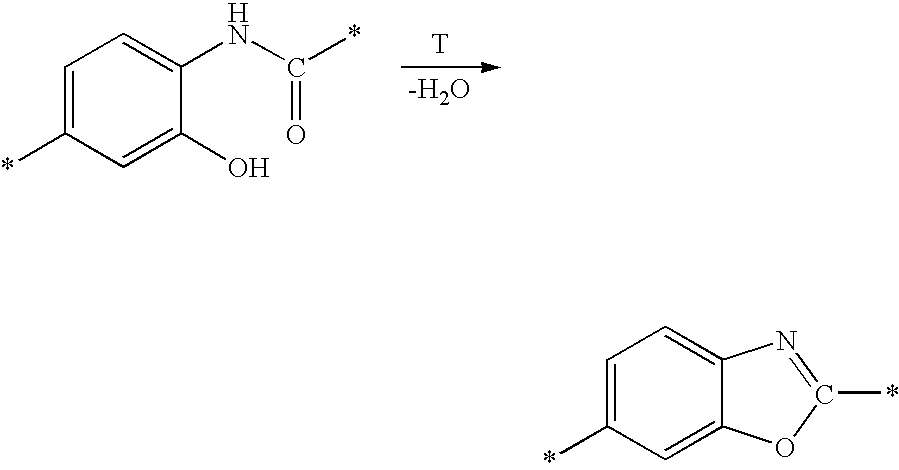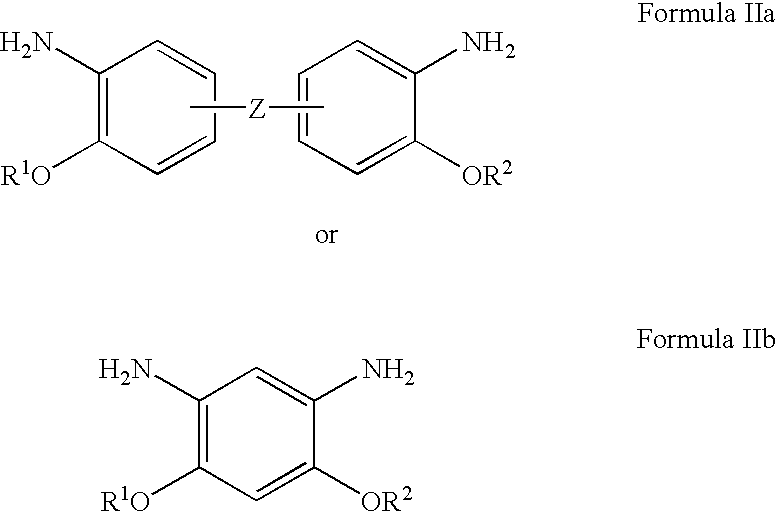Bis-o-aminophenol derivatives, poly-o-hydroxyamides, and polybenzoxazoles, usable in photosensitive compositions, dielectrics, buffer coatings, and microelectronics
- Summary
- Abstract
- Description
- Claims
- Application Information
AI Technical Summary
Benefits of technology
Problems solved by technology
Method used
Image
Examples
example 1
Preparation of 2,2-bis(3,3′-amino-4,4′-tert-butoxycarbonyloxyphenyl)hexafluoropropane (see EP 0 378 156 A2)
In a three-neck round-bottom flask, 26.1 g (0.15 mol) of sodium dithionite (Na2S2O4) and 12 g (0.3 mol) of sodium hydroxide (NaOH) are dissolved under nitrogen in 210 ml of distilled water, with stirring. Then a solution of 18.8 g (0.03 mol) of 2,2′-bis(3,3′-nitro-4,4′-tert-butoxycarbonyloxyphenyl)hexafluoropropane in 260 ml of tetrahydrofuran (THF) is introduced slowly, dropwise into the first solution at room temperature and the mixture is stirred at room temperature for 6 hours. Approximately 150 ml of THF are then distilled off under reduced pressure in a rotary evaporator at 40° C. and the remaining reaction solution is extracted with three times 80 ml of ethyl acetate. The combined ethyl acetate extracts are first washed with twice 50 ml of distilled water and then with three times 100 ml of 1% strength hydrochloric acid (in water), the temperature of the acid at the beg...
example 2
Preparation of 3,3′-amino-4,4′-tert-butoxy-carbonyloxybiphenyl
The synthesis is carried out in the same way as described in Example 1 but in this case using as starting material 14.3 g (0.03 mol) of 3,3′-nitro-4,4′-tert-butoxycarbonyloxybiphenyl and using dioxane instead of THF as solvent. All other worksteps and conditions are the same.
18.2 g of product are obtained.
The compound had the following elemental composition: 63.3% C; 6.9% H; 6.6% N.
Mass Spectrum
A molecule peak was found at 416.
example 3
Preparation of 3,3′-amino-4,4′-tert-butoxy-carbonyloxydiphenyl ether
The synthesis is carried out in the same way as described in Example 1 but in this case using as starting material 14.8 g (0.03 mol) of 3,3′-nitro-4,4′-hydroxydiphenyl ether. All other worksteps and conditions are the same.
9.6 g of product are obtained.
The compound had the following elemental composition: 61.0% C; 6.4% H; 6.6% N.
Mass Spectrum
Molecule peak was found at 432.
PUM
| Property | Measurement | Unit |
|---|---|---|
| Photosensitivity | aaaaa | aaaaa |
| Dielectric constant | aaaaa | aaaaa |
Abstract
Description
Claims
Application Information
 Login to View More
Login to View More - R&D
- Intellectual Property
- Life Sciences
- Materials
- Tech Scout
- Unparalleled Data Quality
- Higher Quality Content
- 60% Fewer Hallucinations
Browse by: Latest US Patents, China's latest patents, Technical Efficacy Thesaurus, Application Domain, Technology Topic, Popular Technical Reports.
© 2025 PatSnap. All rights reserved.Legal|Privacy policy|Modern Slavery Act Transparency Statement|Sitemap|About US| Contact US: help@patsnap.com



